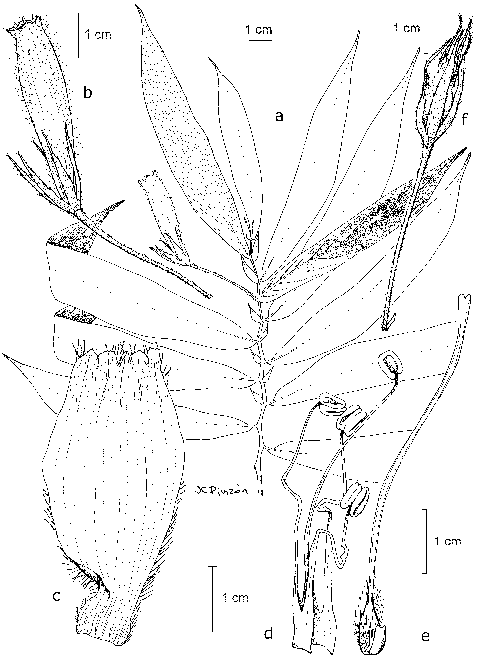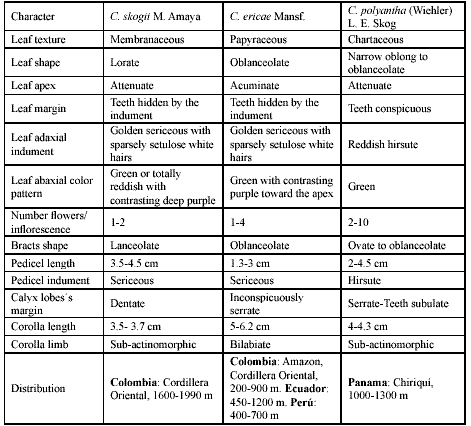Services on Demand
Journal
Article
Indicators
-
 Cited by SciELO
Cited by SciELO -
 Access statistics
Access statistics
Related links
-
 Cited by Google
Cited by Google -
 Similars in
SciELO
Similars in
SciELO -
 Similars in Google
Similars in Google
Share
Caldasia
Print version ISSN 0366-5232On-line version ISSN 2357-3759
Caldasia vol.32 no.1 Bogotá Jan./June 2010
Una nueva especie de Columnea (Gesneriaceae) de la cordillera Oriental en los Andes colombianos
MARISOL AMAYA-MÁRQUEZ
Instituto de Ciencias Naturales, Universidad Nacional de Colombia, Apartado 7495, Bogotá D. C., Colombia. mamayam@unal.edu.co
ABSTRACT
A new species of Columnea belonging to section Collandra (Gesneriaceae) is described and illustrated. The species is found in the Eastern Andes of Colombia (Cordillera Oriental), in the Departamento of Santander.
Key words. Collandra, Columnea, Gesneriaceae, Colombia, Santander, Taxonomy, Flora of Colombia.
RESUMEN
Se describe e ilustra una nueva especie de Columnea perteneciente a la sección Collandra (Gesneriaceae). La nueva especie se encontró en el norte de la Cordillera Oriental en el departamento de Santander en Colombia.
Palabras clave. Collandra, Columnea, Gesneriaceae, Colombia, Santander, Taxonomía, Flora de Colombia.
Recibido: 27/08/2009
Aceptado: 03/11/2009
INTRODUCTION
Collandra is the largest section within the genus Columnea L. (Kvist & Skog 1993) with 60 species recognized so far (Amaya-Márquez et al. en prep.). The species belonging to this section are recognized by having dorsiventral climbing shoots, leaves in each node very unequal in size -the smaller looking like a stipule and the larger of regular size with leaf blade usually oblanceolate. Additionally most species of section Collandra have purple or reddish marks on the abaxial side of the leaves producing distinctive patterns of taxonomic value to discriminate between species; these colored patterns on the leaves signal to the hummingbirds the presence of flowers (Morley 1973, 1974). Most often the inflorescences are hidden under the foliage due to the dorsiventral orientation of the vegetative shoots, and often the corolla is covered by big bracts. In this paper I describe a new species of Columnea belonging to section Collandra (Gesneriaceae), which is unusual within the section by having lorate leaves, long pedicels, small bracts, and long cylindric corollas. The combination of these characters exposes flowers outside the foliage.
Columnea (Collandra) skogii M. Amaya, sp. nov.
TYPE: COLOMBIA. Santander: municipio Suaita, inspección de policía San José de Suaita, camino al bosque de la fundación San Cipriano (6º 9' N, 73º 27' W), 1600 m alt., Nov. 8 1988, Galeano 6098 (holotype: COL). Figure 1.

A Columnea ericae Mansf. differt foliis loratis, floribus longe pedicellatis, bracteis minutis, corollis curtioribus cum, limbo subactinomorpho.
Suffrutescent vines; often branched; stem quadrangular, 0.2-0.5 cm diam., apically sericeous with 10-12 celled uniseriate trichomes, internodes 0.7-2 cm long. Leaves opposite, strongly anysophyllous in a pair, membranaceous; larger leaf sessile or shortly petiolate, petioles 0.1-0.3 cm long; blade asymmetrical, lorate 9.5-18 x 1.2-3 cm, base oblique, apex attenuate, margin slightly serrate, adaxially green, densely sericeous with 8-10 celled trichomes and with sparsely distributed white unicellular setulose hairs; abaxially green or reddish with contrasting deep purple in the apical half or two third (2/3) of the leaf, sericeous with 5-celled trichomes, more densely packed on the veins, 8-9 veins on the larger side of the blade; smaller leaf sessile, blade asymmetrical, lanceolate 1-2 x 0.3-0.7 cm, base oblique, apex attenuate, adaxially green, sericeous with 8 celled trichomes, veins obscure; abaxially golden sericeous with 5 celled trichomes. Inflorescence 1-2 flowers on the larger leaf axil; bracts 1-2, yellow, densely sericeous, lanceolate, 0.4-1 x 0.2-0.5 cm. Flower pedicelate, pedicel 3.5-5 cm long, densely sericeous. Calyx yellow-greenish; lobes 5, nearly free; lanceolate, 1.4-2.5 x 0.2-0.4 cm, margin dentate, two teeth each side, outside densely sericeous, inside glabrous. Corolla oblique in the calyx, yellow; cylindrical 3.5-3.7 cm long, constricted at the base 0.3 cm, 1 cm at the widest part in the upper half, constricted at the limb 0.7 cm; dorsally gibbous, gibbosity 0.4 x 0.5 cm; limb subactinomorphic slightly ampliate, lobes subequal 0.2-0.3 x 0.2 cm, deltoid apically obtuse or acute; outside pilose with 8-12 celled uniseriate hairs apically glandular, inside sparsely sericeous. Androecium of 4 stamens, filaments 2.7-4.5 cm long, glabrous, basally connate 0.3 cm of their length forming a staminal blade. Nectary one dorsal bidentate gland. Gynoecium with the ovary ovoid 0.7 x 0.3 cm, densely sericeous; style 2.8-3.5 cm long, glabrous; stigma bilobulated. Fruit a green ovoid berry, 1.5 x 1 cm. Seeds brown 1 x 1 mm, elliptically striated.
Etymology. The species is named after Laurence Edgar Skog to whom this species is dedicated in acknowledgment of his great contribution to the knowledge and understanding of the Neotropical Gesneriaceae.
Phenology: Flowers and fruits recorded in May and November. This species possibly produces flowers and fruits all year round as do many other columneas. The fruit color information comes from a specimen's label which can lead to uncertainty about the fruit color at maturity.
Distribution. Columnea skogii is known only from the Andean forests in Colombia. The species was recorded on the East Cordillera at the Departament of Santander, between 1600-1900 m of elevation.
Representative specimens: COLOMBIA. Santander: Municipio de Suaita, corregimiento San José, Fundation San Cipriano, ca. 1650-1900 m, May 16 1998, Betancur 7846 (COL); Corregimiento de Virolín, vereda Corbaraque, sitio Costilla de Fara, 1900 m, Oct. 29 2008, Manjarrés 12 (UPTC).
Distinctive features The species is distinguished from the similar C. ericae Mansf., and C. polyantha (Whieler) L. E. Skog by having the larger leaf in a pair lorate. Additional characters that help to distinguish C. skogii from those species are presented in Table 1.
Table 1. Comparison of C .skogii with morphological similar species.

ACKNOWLEDGMENTS
To the National University of Colombia for the opportunity to do research. To Juan Carlos Pinzón for the elaboration of the drawings. To Diego Giraldo-Cañas, Alaim Chautems, and an anonymous reviewer all of whose comments greatly helped improve the manuscript.
LITERATURE CITED
1. KVIST, L.P. & L.E. SKOG. 1993. The genus Columnea (Gesneriaceae) in Ecuador. Allertonia 6: 327 - 400. [ Links ]
2. MORLEY, B. D. 1973. Ecological factors of importance to Columnea taxonomy. In: Heywood, V. (ed.). Taxonomy & Ecology 265 - 281. Academic Press, New York. [ Links ]
3. MORLEY, B. D. 1974. Notes on some critical characters in Columnea classification. Ann. Missouri Bot. Gard. 61:514-525. [ Links ]














